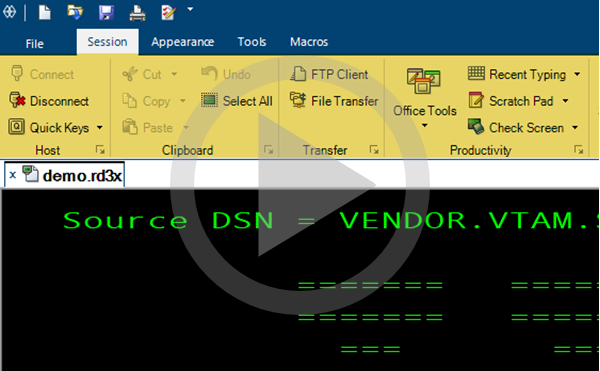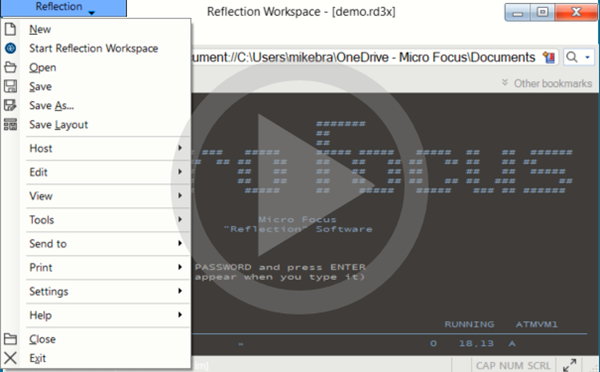The User Interface
With Reflection Desktop, you can display sessions in five types of user interface modes: Ribbon, Browser, TouchUx, Classic, and Classic MDI.
The Ribbon
The Ribbon interface shares the look and feel of Microsoft Office. In the area between the Quick Access toolbar (the toolbar in the upper-left corner) and the document window is the ribbon, a dynamic, collapsible device that organizes commands, buttons, and other controls on tabs for each task area.

Double-click any tab in the Ribbon to hide or show the Ribbon. Or, if you prefer, you can map a keyboard shortcut to show or hide the Ribbon with a keystroke.Sessions using the default 3270 or 5250 keyboard map already have this action mapped to CTRL+F1.
The Browser
The Browser interface has a look and feel that is similar to the latest Web browsers.

You can access commands from the Reflection menu or from the Quick Access Toolbar. You can also access commands by searching for them in the search box and then clicking on the search results.
TouchUx
The TouchUx interface provides the Reflection TouchUx user experience. Reflection runs on Microsoft Windows devices or other devices (Apple iPad or Android) that are accessing sessions running on a Citrix server. This mode includes an on-screen terminal keyboard that can be set as a transparent overlay or docked in a separate pane.

Classic
A Classic interface option provides an interface that is familiar to users of previous versions of Reflection. When using the Classic UI, only one document can be open in a workspace, and other features may not be available.
Classic MDI
The Classic MDI option is similar to the Classic option. Unlike Classic, it provides a multi-document interface that allows more than one document to be open in a workspace.
To select the interface type
-
Open the Reflection Workspace Settings dialog box.
The steps depend on your user interface mode.
User Interface Mode Steps Ribbon On the File menu or the Reflection button  (if using the Office 2007 Look and Feel), choose Reflection Workspace Settings.
(if using the Office 2007 Look and Feel), choose Reflection Workspace Settings.Reflection Browser On the Reflection menu, choose Settings and then Reflection Workspace Settings. TouchUx Tap the Gear icon and then select Reflection Workspace Settings. -
Click Configure User Interface to open the User Interface dialog box.
-
In the User interface mode list, select the type of interface that you want to use.
-
To select a look and feel for the Ribbon or TouchUx interfaces, choose from the options in the Look and Feel / Color scheme list.
-
Close and reopen the workspace.
Workspace and Layouts
Most of your work in Reflection will be done in the application frame, which is called the workspace.
You can configure your workspace with several different types of "look and feel" settings that provide different ways to access the workspace menu, which contains layout options, application and document settings, and a list of recent documents.
The Steps to open your workspace settings dialog box depend on your User Interface Mode.
| User Interface Mode | Steps |
|---|---|
| Ribbon | On the File menu or the Reflection button  (if using the Office 2007 Look and Feel), choose Reflection Workspace Settings. (if using the Office 2007 Look and Feel), choose Reflection Workspace Settings. |
| Reflection Browser | On the Reflection menu, choose Settings and then Reflection Workspace Settings. |
| TouchUx | Tap the Gear icon and then select Reflection Workspace Settings. |
The workspace incorporates these elements:
The size and location of the workspace, along with all open terminal sessions, Web pages, and task panes, is referred to as the layout. You can save the settings of a layout to a file. When reopened, a layout file automatically opens the saved documents and repositions the workspace to the specified size and location.
note
If you are using the Classic user interface mode, you can arrange multiple sessions on your desktop and save them in a layout.
Documents
A document is a file that specifies the settings and behavior of a terminal session, a Web page, a printer session, or an FTP client session.
When you open a document, the related session or Web page is opened, either in the workspace (for terminal sessions and Web pages) or in a separate window (for printer sessions and FTP client sessions).
The document for a terminal session contains configuration settings for host-specific information. It also includes pointers to other files that are used to control the appearance of the session, such as the theme file, and to files that control input and text handling, such as the keyboard map file and the Ribbon file.
You can open any number of terminal sessions or Web pages in the workspace.The document name appears on the tab label unless a different name has been specified in a layout. The name of the selected document appears in the title bar of the workspace.
Appearance
You can control the appearance of documents in the workspace using themes, which combine color specifications for text and backgrounds, cursor types, and sounds for session-level events.
You can also select a color scheme for the workspace and ribbon background and sounds for workspace events.
In this section
 Using the Reflection Ribbon
Using the Reflection Ribbon Using the Reflection Browser
Using the Reflection Browser